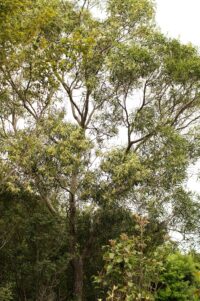Acacia maidenii, commonly known as Maiden’s Wattle, is a fast-growing, evergreen tree native to southeastern Australia.
It is notable for its ornamental foliage and its ability to fix nitrogen in the soil, which improves soil fertility.
Taxonomy:
- Family: Fabaceae
- Subfamily: Mimosoideae
- Genus: Acacia
Description:
- Growth: Tree typically reaches heights of 10 to 20 meters, bark is smooth and grey-green when young, becoming darker and fissured as it matures.
- Leaves: Dark green, glossy, and lanceolate to narrowly elliptic. They can be up to 20 cm long and 5 cm wide.
- Flowers: Pale yellow to cream-colored, globular flower heads that are fragrant and appear in clusters. Flowering usually occurs from late winter to early summer.
- Pods: Elongated pods, up to 10 cm long, containing several seeds. The pods are initially green, maturing to brown as they dry.
Habitat and Distribution:
Acacia maidenii is adaptable to a variety of soils, including sandy, loamy, and clay soils, and prefers well-drained conditions. It thrives in both full sun and partial shade and is tolerant of drought and frost. This species is often found in coastal and near-coastal environments, thriving in subtropical and warm temperate regions.
Hosts: (included but not limited to)
- Green Tree Ants (Oecophylla smaragdina): Building nests by weaving leaves together using silk produced by their larvae. Green tree ants defend their nests vigorously against potential threats, providing the tree with protection from herbivores in exchange for shelter and access to extrafloral nectar.
- Wattle Acacia Blue (Theclinesthes serpentata): The larvae feed on the foliage of acacias, including this species, while the adults feed on nectar from the tree’s flowers.
- Acacia Longicorn Beetle (Agrianome spinicollis): Larvae develop within the wood of the tree, contributing to the decomposition processes and nutrient cycling within the ecosystem.
Ecology and Uses:
- Ornamental: Acacia maidenii is cultivated as an ornamental tree in gardens and parks for its attractive foliage and flowers.
- Soil Improvement: Its nitrogen-fixing ability makes it useful for improving soil fertility, particularly in degraded lands.
- Timber: The wood is sometimes used for fuel and small-scale timber applications.
- Traditional Uses: Indigenous Australian communities have used parts of the plant for various purposes, including as a source of fiber and for medicinal purposes.
Links:
Acacia maidenii : Maiden’s Wattle | Atlas of Living Australia (ala.org.au)





